Relationship between Urban Floating Population Distribution and Livability Environment: Evidence from Guangzhou’s Urban District, China
Abstract
1. Introduction
2. Concept and Methods
2.1. Conceptual Framework of Livability Environment on the Residential Location Choice of the Floating Population
2.1.1. Physical Environment
2.1.2. Social Environment
2.1.3. Life Convenience
2.2. Study Area
2.3. Research Design, and Indicator System and Model
2.4. Data and Data Sources
2.5. Methods
2.5.1. Evaluation Method of Community Index Score
2.5.2. Analysis Method of Spatial Autocorrelation and Spatial Agglomeration of Foreign Population
2.5.3. Spatial Regression Model
3. Results and Discussions
3.1. Spatial Difference Pattern of the Floating Population
3.2. Characteristics of Spatial Difference Pattern of the Livability Environment
3.3. Relationship between Urban Floating Population Distribution and Livability Environment in Guangzhou’s Urban District
4. Discussion and Conclusions
4.1. Discussion
4.2. Conclusions
Author Contributions
Funding
Institutional Review Board Statement
Informed Consent Statement
Conflicts of Interest
References
- Xiao, Y.; Wang, J.; Huang, H. Does economic development bring more livability? Evidence from Jiangsu Province, China. J. Clean. Prod. 2021, 293, 126187. [Google Scholar]
- Wu, W. Migrant Intra-urban Residential Mobility in Urban China. Hous. Stud. 2006, 21, 745–765. [Google Scholar] [CrossRef]
- Huang, X.; Dijst, M.; van Weesep, J.; Jiao, Y.; Sun, Y. Residential Choice among Rural-Urban Migrants afterHukouReform: Evidence from Suzhou, China. Popul. Space Place 2016, 23, e2035. [Google Scholar] [CrossRef]
- Zhu, P.; Zhao, S.; Wang, L.; Al Yammahi, S. Residential segregation and commuting patterns of migrant workers in China. Transp. Res. Part D Transp. Environ. 2017, 52, 586–599. [Google Scholar] [CrossRef]
- Bhat, C.; Guo, J.Y. A comprehensive analysis of built environment characteristics on household residential choice and auto ownership levels. Transp. Res. Part B Methodol. 2007, 41, 506–526. [Google Scholar] [CrossRef]
- Liao, F.H.; Farber, S.; Ewing, R. Compact development and preference heterogeneity in residential location choice behaviour: A latent class analysis. Urban Stud. 2014, 52, 314–337. [Google Scholar] [CrossRef]
- Ettema, D.; Nieuwenhuis, R. Residential self-selection and travel behaviour: What are the effects of attitudes, reasons for location choice and the built environment? J. Transp. Geogr. 2017, 59, 146–155. [Google Scholar] [CrossRef]
- Kroesen, M. Residential self-selection and the reverse causation hypothesis: Assessing the endogeneity of stated reasons for residential choice. Travel Behav. Soc. 2019, 16, 108–117. [Google Scholar] [CrossRef]
- Lotfi, S.; Despres, C.; Lord, S. Are sustainable residential choice also desirable? A study of household satisfaction and aspirations with regard to current and future residential location. J. Hous. Bulit Environ. 2019, 34, 283–311. [Google Scholar] [CrossRef]
- Yin, L.; Muller, B. Residential location and the biophysical environment: Excurban development agents in a heterogeneous landscape. Environ. Plan. B-Plan. Design 2007, 34, 279–295. [Google Scholar] [CrossRef]
- Róbek, S.; Trojanek, M.; Źróbek-Sokolnik, A.; Trojanek, R. The influence of environmental factors on property buyers’ choice of residential location in Poland. J. Int. Stud. 2015, 7, 163–173. [Google Scholar]
- Tu, G.; Abildtrup, J.; Garcia, S. Preferences for urban green spaces and peri-urban forests: An analysis of stated residential choices. Landsc. Urban Plan. 2016, 148, 120–131. [Google Scholar] [CrossRef]
- Wang, Y.; Wu, K.; Qin, J.; Wang, C.; Zhang, H. Examining Spatial Heterogeneity Effects of Landscape and Environment on the Residential Location Choice of the Highly Educated Population in Guangzhou, China. Sustainability 2020, 12, 3869. [Google Scholar] [CrossRef]
- Brasington, D.M.; Hite, D. Demand for environmental quality: A spatial hedonic analysis. Reg. Sci. Urban Econ. 2005, 35, 57–82. [Google Scholar] [CrossRef]
- Diao, M.; Qin, Y.; Sing, T.F. Negative Externalities of Rail Noise and Housing Values: Evidence from the Cessation of Railway Operations in Singapore. Real Estate Econ. 2015, 44, 878–917. [Google Scholar] [CrossRef]
- Gurran, N.; Phibbs, P. When Tourists Move In: How Should Urban Planners Respond to Airbnb? J. Am. Plan. Assoc. 2017, 83, 80–92. [Google Scholar] [CrossRef]
- Chu, Y.-L.; Deng, Y.; Liu, R. Impacts of New Light Rail Transit Service on Riders’ Residential Relocation Decisions. J. Public Transp. 2017, 20, 152–165. [Google Scholar] [CrossRef][Green Version]
- Lasley, P. Influence of Transportation on Residential Choice: A Survey of Texas REALTORS® on Factors Affecting Housing Location Choice; Texas A&M University: Texas College Station, TX, USA, 2017. [Google Scholar]
- Rhodes, A.; Deluca, S. Residential mobility and school choice among poor families. Choos. Homes Choos. Sch. 2014, 137–166. [Google Scholar]
- Cho, E.J.; Rodriguez, D.; Song, Y. The Role of Employment Subcenters in Residential Location Decisions. J. Transp. Land Use 2008, 1. [Google Scholar] [CrossRef]
- Vega, A.; Reynolds-Feighan, A. A methodological framework for the study of residential location and travel-to-work mode choice under central and suburban employment destination patterns. Transp. Res. Part A Policy Pract. 2009, 43, 401–419. [Google Scholar] [CrossRef]
- Jiang, W.; Feng, T.; Timmermans, H.; Li, H. A gap-theoretical path model of residential satisfaction and intention to move house applied to renovated historical blocks in two Chinese cities. Cities 2017, 71, 19–29. [Google Scholar] [CrossRef]
- Harvey, D. Social Justice and the City; Johns Hopkins University Press: Baltimore, MD, USA, 1973. [Google Scholar]
- Cassel, E.; Mendelsohn, R. The choice of functional forms for hedonic price equations: Comment. J. Urban Econ. 1985, 18, 135–142. [Google Scholar] [CrossRef]
- Wang, Y.; Wu, K.; Jin, L.; Huang, G.; Zhang, Y.; Su, Y.; Zhang, H.; Qin, J. Identifying the Spatial Heterogeneity in the Effects of the Social Environment on Housing Rents in Guangzhou, China. Appl. Spat. Anal. Policy 2021, 14, 849–877. [Google Scholar] [CrossRef]
- Guo, J.Y.; Bhat, C.R. Operationalizing the concept of neighborhood: Application to residential location choice analysis. J. Transp. Geogr. 2007, 15, 31–45. [Google Scholar] [CrossRef]
- Jiang, W.; Timmermans, H.J.P.; Li, H.; Feng, T. Mixed logit model of intended residential mobility in renovated historical blocks in China. In Proceedings of the DDSS Conference, Technische Universiteit Eindhoven, Eindhoven, The Netherlands, 27–28 June 2016; pp. 1–15. [Google Scholar]
- Musterd, S.; van Gent, W.; Das, M.; Latten, J. Adaptive behaviour in urban space: Residential mobility in response to social distance. Urban Stud. 2014, 53, 227–246. [Google Scholar] [CrossRef]
- Basolo, V.; Yerena, A. Residential mobility of low-income, subsidized households: A synthesis of explanatory frameworks. Hous. Stud. 2016, 32, 841–862. [Google Scholar] [CrossRef]
- Li, S.; Lyu, D.; Huang, G.; Zhang, X.; Gao, F.; Chen, Y.; Liu, X. Spatially varying impacts of built environment factors on rail transit ridership at station level: A case study in Guangzhou, China. J. Transp. Geogr. 2020, 82, 102631. [Google Scholar] [CrossRef]
- Zhou, S.; Deng, L.; Kwan, M.-P.; Yan, R. Social and spatial differentiation of high and low income groups’ out-of-home activities in Guangzhou, China. Cities 2015, 45, 81–90. [Google Scholar] [CrossRef]
- Han, Y.; Wu, X. Language policy, linguistic landscape and residents’ perception in Guangzhou, China: Dissents and conflicts. Curr. Issues Lang. Plan. 2020, 21, 229–253. [Google Scholar] [CrossRef]
- Wang, Y.; Wu, K.; Zhao, Y.; Wang, C.; Zhang, H. Examining the Effects of the Built Environment on Housing Rents in the Pearl River Delta of China. Appl. Spat. Anal. Policy 2021, 1–25. [Google Scholar] [CrossRef]
- Chu, L.; Wen, H. Temporal and Spatial Effects of Urban Center on Housing Price—A Case Study on Hangzhou, China. World J. Soc. Sci. Res. 2018, 5, 89. [Google Scholar] [CrossRef]
- Czembrowski, P.; Kronenberg, J. Hedonic pricing and different urban green space types and sizes: Insights into the discussion on valuing ecosystem services. Landsc. Urban Plan. 2016, 146, 11–19. [Google Scholar] [CrossRef]
- Kim, H.N.; Boxall, P.C.; Adamowicz, W. Analysis of the economic impact of water management policy on residential prices: Modifying choice set formation in a discrete house choice analysis. J. Choice Model. 2018, 33, 100148. [Google Scholar] [CrossRef]
- Nelson, A.C.; Genereux, J.; Genereux, M. Price Effects of Landfills on House Values. Land Econ. 1992, 68, 359. [Google Scholar] [CrossRef]
- Banfi, S.; Filippini, M.; Horehájová, A. Valuation of Environmental Goods in Profit and Non-Profit Housing Sectors: Evidence from the Rental Market in the City of Zurich. Swiss J. Econ. Stat. 2008, 144, 631–654. [Google Scholar] [CrossRef]
- Rava, M.; Marcon, A.; Girardi, P.; Pironi, V.; Silocchi, C.; Ricci, P.; de Marco, R. Proximity to wood factories and hospitalizations for respiratory diseases in children. Sci. Total Environ. 2011, 410-411, 80–86. [Google Scholar] [CrossRef] [PubMed]
- Wang, Y.; Zhao, L.; Sobkowiak, L.; Guan, X.; Wang, S. Impact of urban landscape and environmental externalities on spatial differentiation of housing prices in Yangzhou City. J. Geogr. Sci. 2015, 25, 1122–1136. [Google Scholar] [CrossRef]
- Saunders, P. Domestic property and social class. Int. J. Urban Reg. Res. 1978, 2, 233–251. [Google Scholar] [CrossRef]
- Lockwood, D. Mapping crime in Savannah—Social disadvantage, land use, and violent crimes reported to the police. Soc. Sci. Comput. Rev. 2007, 25, 194–209. [Google Scholar] [CrossRef]
- Raphael, S.; Winter-Ebmer, R. Identifying the Effect of Unemployment on Crime. J. Law Econ. 2001, 44, 259–283. [Google Scholar] [CrossRef]
- Cervero, R.; Wu, K.-L. Polycentrism, Commuting, and Residential Location in the San Francisco Bay Area. Environ. Plan. A Econ. Space 1997, 29, 865–886. [Google Scholar] [CrossRef] [PubMed]
- Kim, J.H.; Pagliara, F.; Preston, J. The Intention to Move and Residential Location Choice Behaviour. Urban Stud. 2005, 42, 1621–1636. [Google Scholar] [CrossRef]
- Humphreys, J.; Ahern, A. Is travel based residential self-selection a significant influence in modal choice and household location decisions? Transp. Policy 2019, 75, 150–160. [Google Scholar] [CrossRef]
- Phe, H.H.; Wakely, P. Status, Quality and the Other Trade-off: Towards a New Theory of Urban Residential Location. Urban Stud. 2000, 37, 7–35. [Google Scholar] [CrossRef]
- Goodman, A.C.; Thibodeau, T.G. Housing market segmentation and hedonic prediction accuracy. J. Hous. Econ. 2003, 12, 181–201. [Google Scholar] [CrossRef]
- Stevenson, S. New empirical evidence on heteroscedasticity in hedonic housing models. J. Hous. Econ. 2004, 13, 136–153. [Google Scholar] [CrossRef]
- Wittowsky, D.; Hoekveld, J.; Welsch, J.; Steier, M. Residential housing prices: Impact of housing characteristics, accessibility and neighbouring apartments—A case study of Dortmund, Germany. Urban Plan. Transp. Res. 2020, 8, 44–70. [Google Scholar] [CrossRef]
- Schirmer, P.M.; van Eggermond, M.A.B.; Axhausen, K.W. The role of location in residential location choice models: A review of literature. J. Transp. Land Use 2014, 7, 3–21. [Google Scholar] [CrossRef]
- Anselin, L. Spatial Econometrics: Methods and Models; Springer: Dordrecht, The Netherlands, 1988; pp. 1–254. [Google Scholar]
- Anselin, L.; Syabri, I.; Kho, Y. GeoDa: An Introduction to Spatial Data Analysis. Geogr. Anal. 2005, 38, 5–22. [Google Scholar] [CrossRef]
- Arbia, G. Spatial Econometrics: Statistical Foundations and Applications to Regional Economic Growth; Springer: Berlin/Heidelberg, Germany, 2006. [Google Scholar]
- Gray, F. Non-Explanation in Urban Geography. Area 1975, 7, 228–234. [Google Scholar]

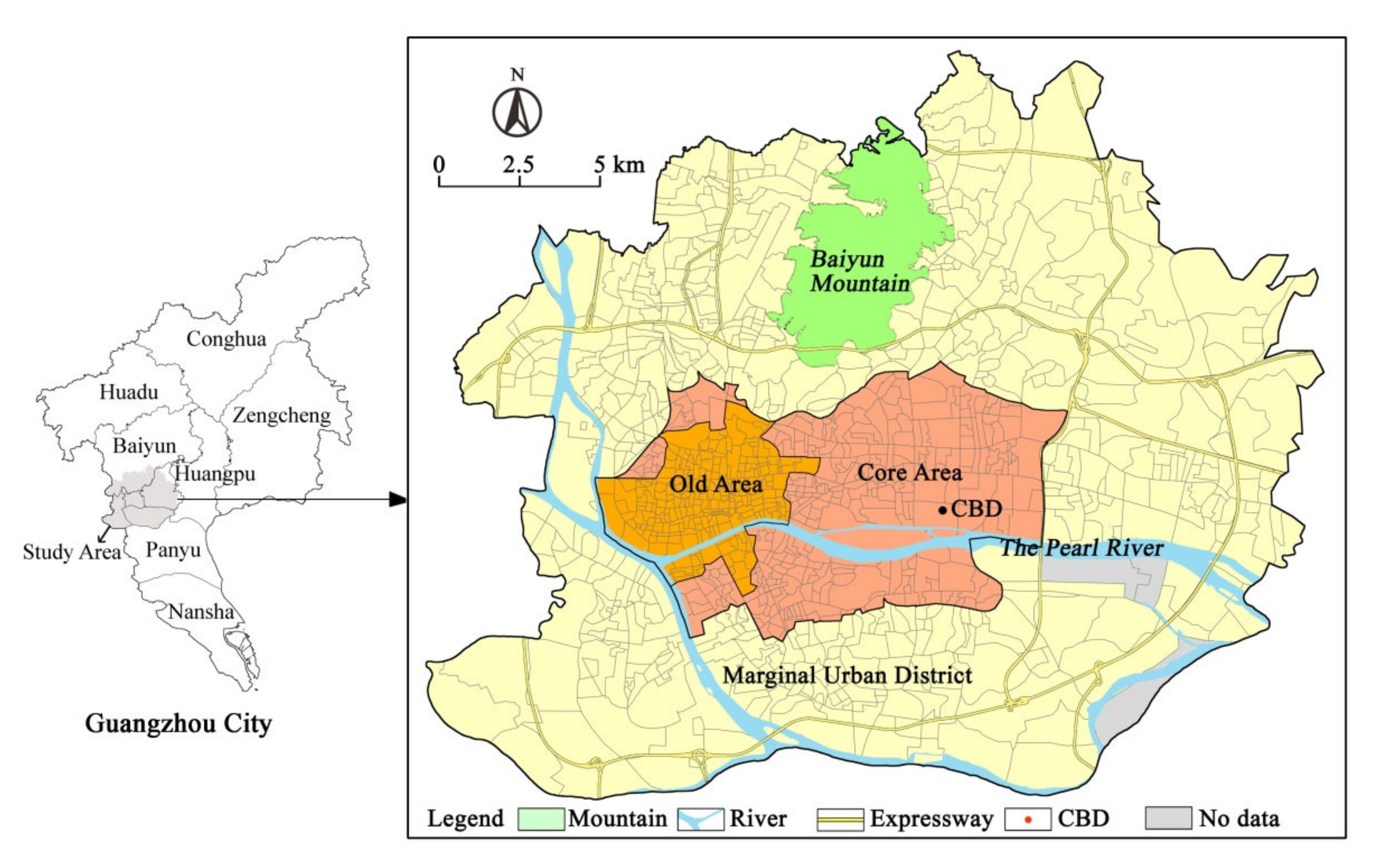
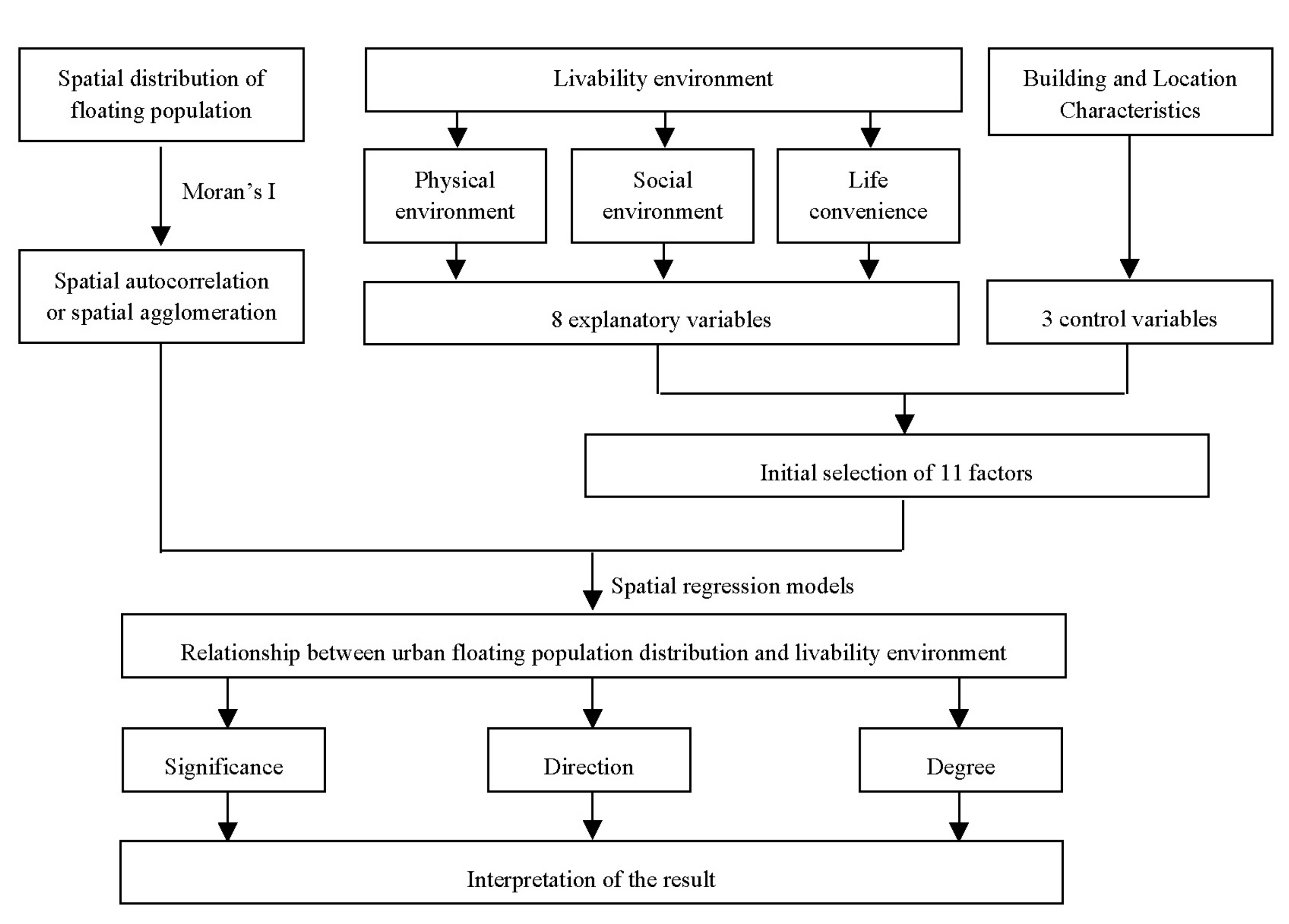
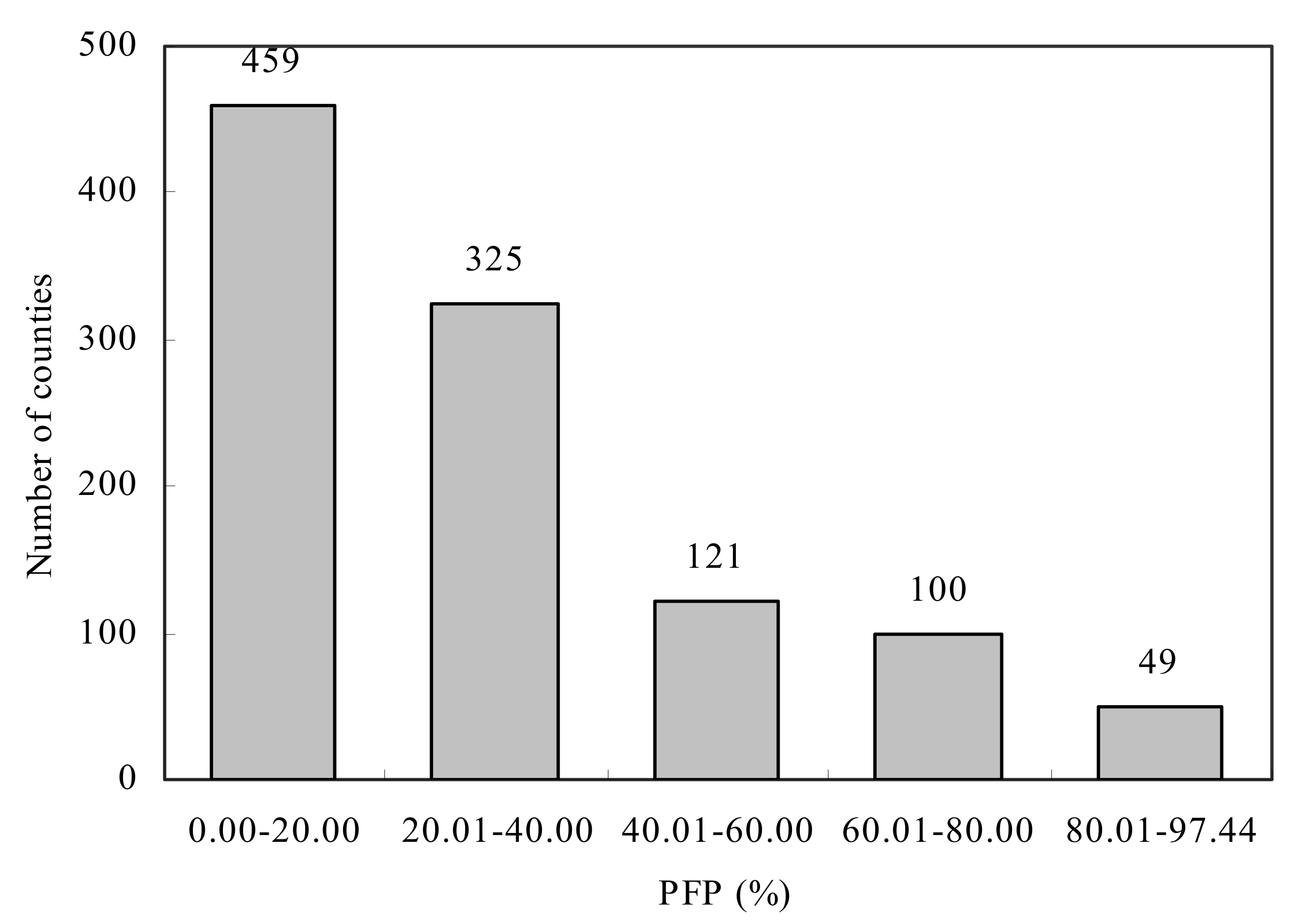
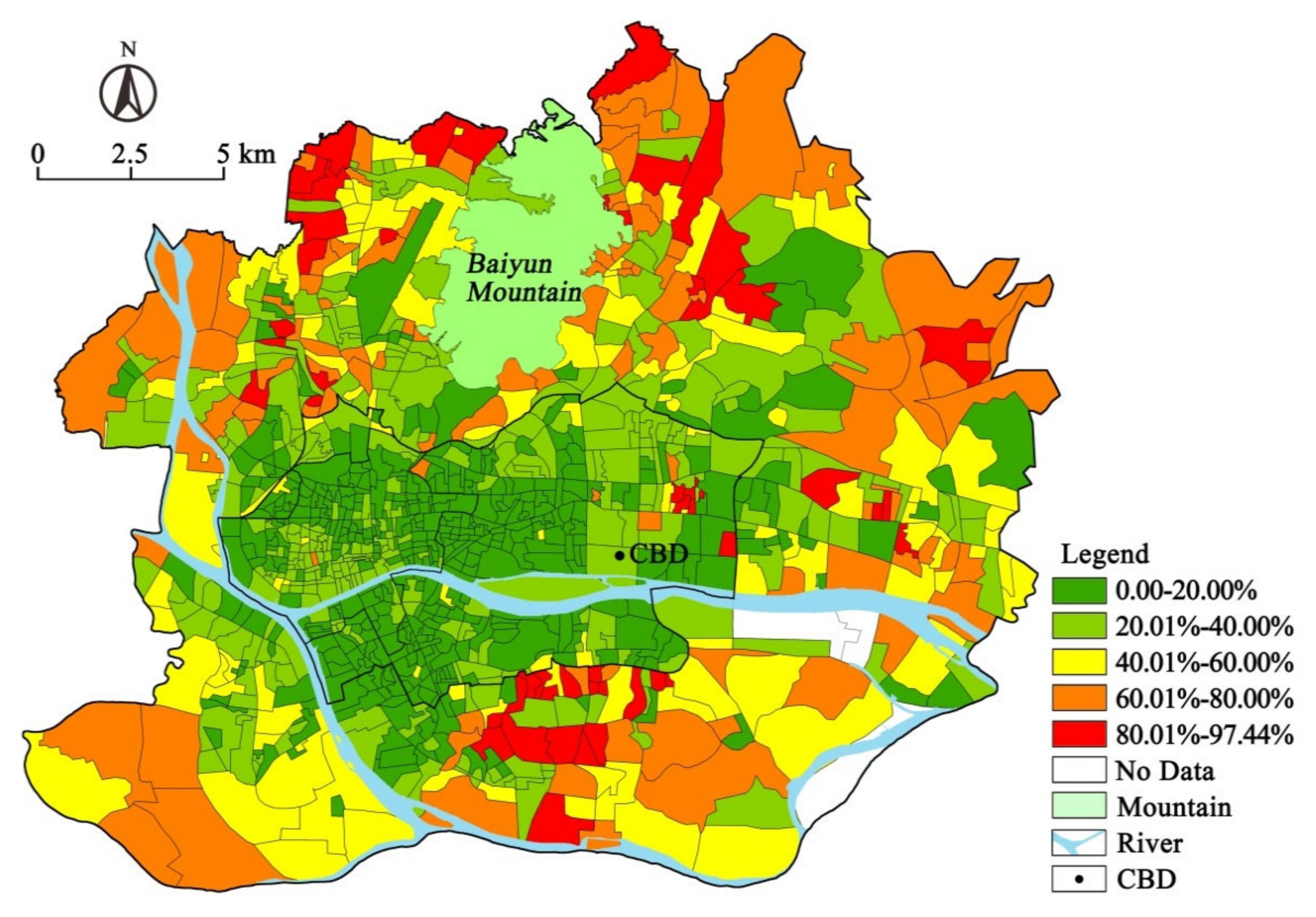
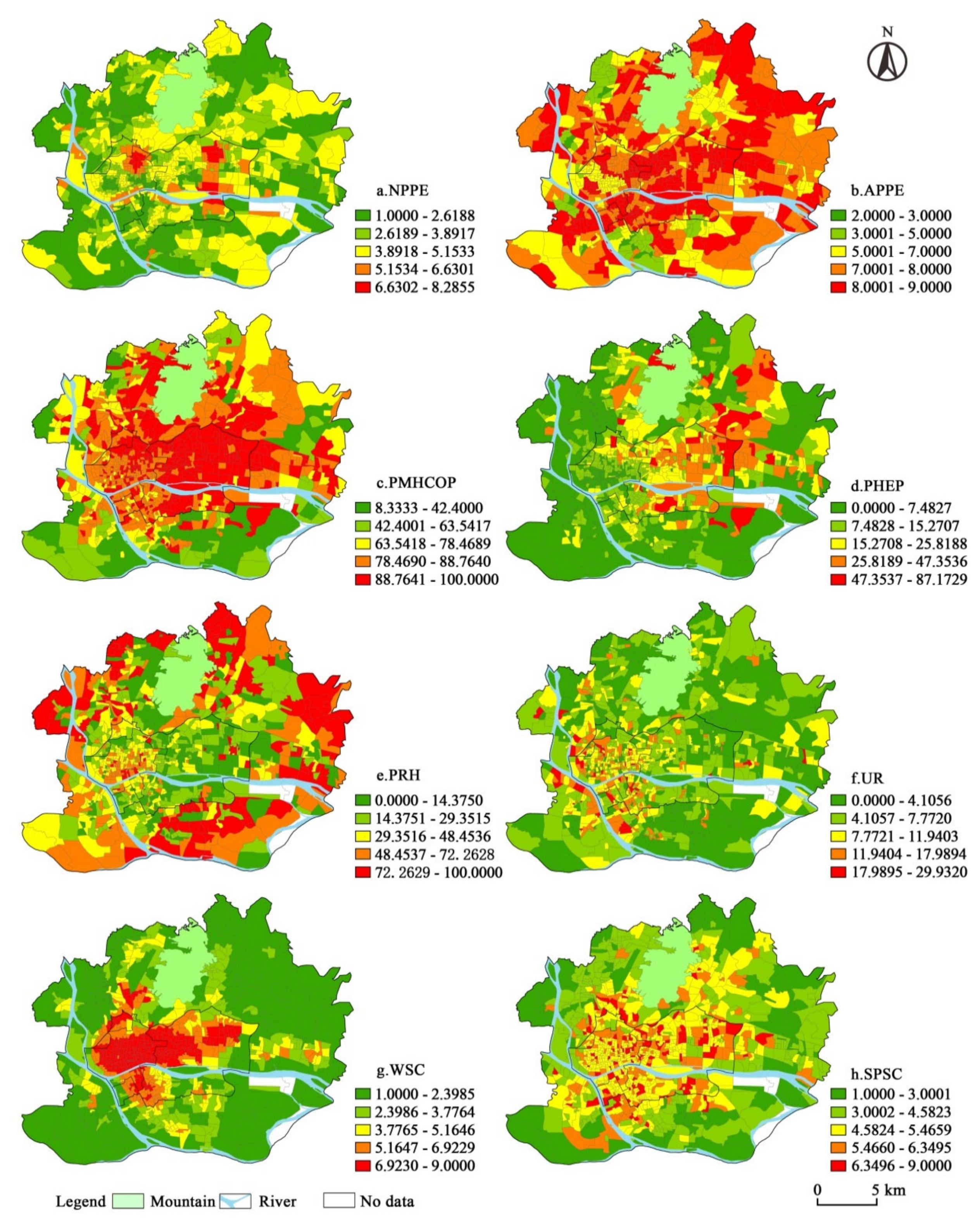
| Variable (Symbol) | Evaluation Method or Index Composition | Expected Impact Direction |
|---|---|---|
| Dependent variable: Proportion of floating population (PFP) | PFP divided by total population. | |
| Explanatory Variables—Physical Environment | ||
| Near-positive physical environment (NPPE) | Comprehensive score for near famous landmarks, parks and waterfronts. | + |
| Avoid negative physical environment (ANPE) | Score for avoiding distasteful transportation facilities and municipal facilities. | + |
| Explanatory Variables—Social Environment | ||
| Proportion of middle- and high-class occupation population (PMHCOP) | middle- and high-class occupation population divided by the employed population; middle- and high-class occupations include (1) management (managers in government departments and other publicly funded agencies, nonprofit organizations, and corporations), (2) professionals, (3) clerks and administrative staff and (4) workers in the retail and service sectors. | + |
| Proportion of highly educated population (PHEP) | Undergraduate or above divided by population aged six years and above. | + |
| Proportion of rental households (PRH) | Rental household divided by total households. | - |
| Unemployment rate (UR) | Unemployed population divided by active people. | - |
| Explanatory Variables—Life Convenience | ||
| Work and shopping convenience (WSC) | Comprehensive score for the accessibility to office space, subway stations, and stores. | + |
| Social public services convenience (SPSC) | Comprehensive score for the conveniences of basic education, medical services, and cultural and physical amenities. | + |
| Control Variables—Building and Location Characteristics | ||
| Building age (BAGE) | Score of the average building age. | + |
| Building area per household (BAREA) | Score of the average building area per household. | + |
| Distance from the CBD (DCBD) | Distance from the IFC (km). | - |
| Tolerance | VIF Value | |
|---|---|---|
| NPPE | 0.8540 | 1.1709 |
| ANPE | 0.8875 | 1.1267 |
| PMHCOP | 0.5630 | 1.7761 |
| PHEP | 0.4700 | 2.1275 |
| PRH | 0.3545 | 2.8212 |
| UR | 0.7080 | 1.4123 |
| WSC | 0.5062 | 1.9755 |
| SPSC | 0.6332 | 1.5792 |
| BAGE | 0.4775 | 2.0944 |
| BAREA | 0.2743 | 3.6461 |
| DCBD | 0.6466 | 1.5465 |
| Model | R2 | AIC | Log-Likelihood |
|---|---|---|---|
| OLS | 0.738748 | 8149.13 | −4062.57 |
| SLM | 0.758831 | 8072.03 | −4023.02 |
| SEM | 0.769824 | 8048.50 | −4012.25 |
| Coefficient | Std. Error | t/z-Value | p | |
|---|---|---|---|---|
| NPPE | −0.2255 | 0.2759 | −0.8172 | 0.4138 |
| ANPE | −0.4869 | 0.3164 | −1.5391 | 0.1238 |
| PMHCOP | −0.1305 * | 0.0309 | −4.2173 | 0.0000 |
| PHEP | −0.1408 * | 0.0387 | −3.6406 | 0.0003 |
| PRH | 0.4379 * | 0.0222 | 19.7005 | 0.0000 |
| UR | −0.9470 * | 0.0786 | −12.0430 | 0.0000 |
| WSC | −1.0479 * | 0.2645 | −3.9621 | 0.0001 |
| SPSC | −0.2973 | 0.3368 | −0.8828 | 0.3774 |
| BAGE | 3.2891 * | 0.3771 | 8.7218 | 0.0000 |
| BAREA | −0.1287 | 0.7100 | −0.1812 | 0.8562 |
| DCBD | 0.3326 | 0.2503 | 1.3286 | 0.1840 |
| CONSTANT | 22.4242 * | 5.7040 | 3.9313 | 0.0001 |
| LAMBDA | 0.5028 * | 0.0458 | 10.9693 | 0.0000 |
| R2: 0.769824; AIC: 8048.50; Log likelihood: −4012.25 | ||||
Publisher’s Note: MDPI stays neutral with regard to jurisdictional claims in published maps and institutional affiliations. |
© 2021 by the authors. Licensee MDPI, Basel, Switzerland. This article is an open access article distributed under the terms and conditions of the Creative Commons Attribution (CC BY) license (https://creativecommons.org/licenses/by/4.0/).
Share and Cite
Wang, Y.; Yue, X.; Zhang, H.; Su, Y.; Qin, J. Relationship between Urban Floating Population Distribution and Livability Environment: Evidence from Guangzhou’s Urban District, China. Sustainability 2021, 13, 13477. https://doi.org/10.3390/su132313477
Wang Y, Yue X, Zhang H, Su Y, Qin J. Relationship between Urban Floating Population Distribution and Livability Environment: Evidence from Guangzhou’s Urban District, China. Sustainability. 2021; 13(23):13477. https://doi.org/10.3390/su132313477
Chicago/Turabian StyleWang, Yang, Xiaoli Yue, Hong’ou Zhang, Yongxian Su, and Jing Qin. 2021. "Relationship between Urban Floating Population Distribution and Livability Environment: Evidence from Guangzhou’s Urban District, China" Sustainability 13, no. 23: 13477. https://doi.org/10.3390/su132313477
APA StyleWang, Y., Yue, X., Zhang, H., Su, Y., & Qin, J. (2021). Relationship between Urban Floating Population Distribution and Livability Environment: Evidence from Guangzhou’s Urban District, China. Sustainability, 13(23), 13477. https://doi.org/10.3390/su132313477







